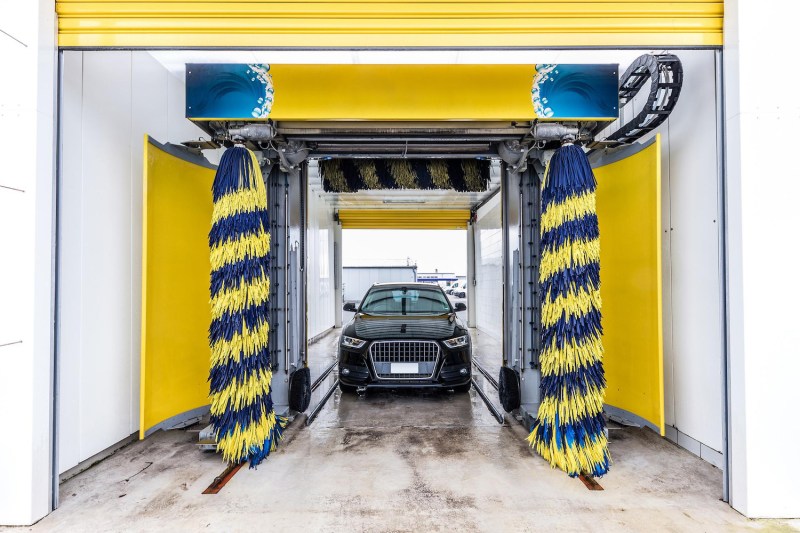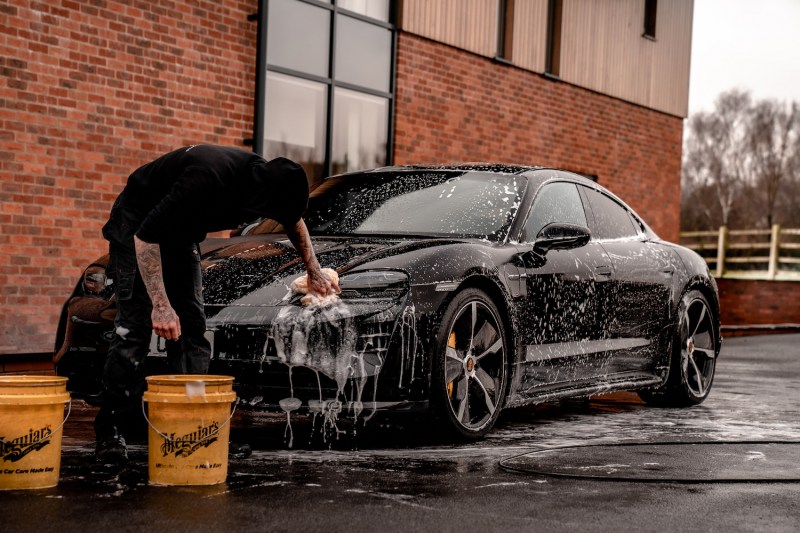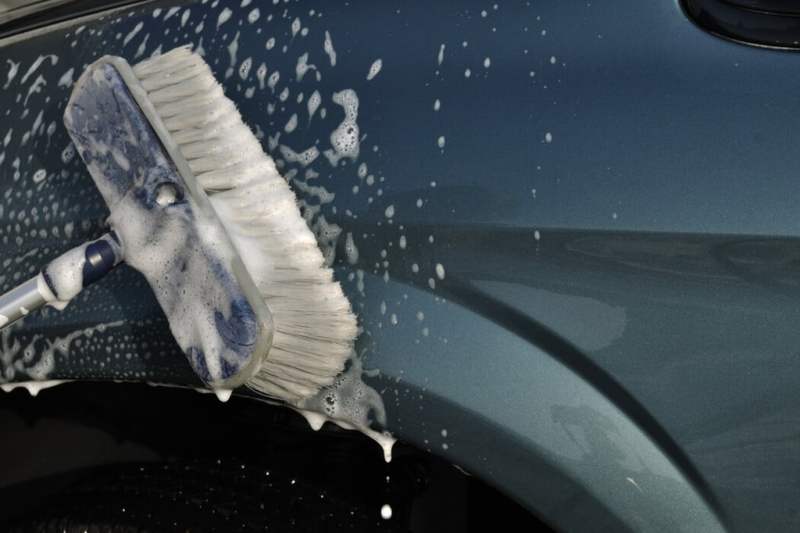With flowers and trees in bloom, chances are your car gets a new layer of dirt daily. Beyond being incredibly annoying, pollen, dirt, bird poop, and other contaminants can ruin your car’s paint job if left to sit too long.
While it’s more convenient to take the easy route and drive your car through a carwash, we believe that you should never, ever, at any time, take your vehicle to a carwash when you can wash your car at home and by hand. If you’re eager to learn the simple process alongside a few tips surrounding what to avoid, continue reading.
Traditional carwashes — the ones with those massive brushes — rarely, or ever, get cleaned. So, all the rocks and dirt that the bristles remove are then flung onto your car. Even if the bristles are cleaned every month, which is highly unlikely, the bristles are doing more damage to your car’s paint job than anything else.
Instead, you should wash your car at home. Even if you don’t go full expert mode where you try to follow a YouTube tutorial, spending a few minutes doing a car wash at home will net you far better results than a carwash. Here's how to wash a car by hand.

Skip the carwash
Carwashes with brushes are brutal on your car’s paint job because they can hold on to debris and dirt cleaned off of other vehicles. Cleaning the brushes is a difficult task that carwash owners often overlook. Taking your car through one of these machines could result in deep scratches, dings, and swirl marks.
If you’re really in a pinch, brushless carwashes are a much better alternative since they don’t have anything that physically touches your car. Instead, they blast your car with water and soap at high pressure. One major downside of brushless carwashes is the water. You don’t know if the water the machine is using has been filtered or if it’s the same water left over from other vehicles.
Plus, if you’re willing to shell out money for a service that blasts your car with water and soap, why not do that with a car wash at home?

Keep it simple
We’ve all seen those videos of YouTube detailers painstakingly agonizing over every millimeter of a car to get it as clean as possible. While the videos are fun to watch, even if it’s just to kill some time, this isn’t the real world. Not everyone has the time, money, or space to spend hours cleaning a car. We get it.
You don’t have to be an expert or have 10 hours of free time to wash a car by hand. You also don’t have to have tons of equipment that takes up half your garage or basement to store. Remember, this is a simple car wash to remove most of the debris and grime from your vehicle. This isn’t the time to get grime out of every nook and cranny.
Find a good spot
Before you prepare your products, find a good spot to wash your car. Washing your car in direct sunlight will cause the water to evaporate quickly, leaving water spots and forcing you to use more water than you would normally have to. It will also force you to work quickly with products that can dry oddly and leave streaks, which you don’t want.
Step 1: Park your car in the shade out of direct sunlight.
Step 2: If you don’t have access to a shady spot, wash your car on a cloudy day.
Hose stuff down
Once you've found a good spot, the next step is to start hosing off your car.
Step 1: Start hosing off your car by the wheels and wheel wells.
Step 2: Spray your tire cleaner onto your tires and let it sit while you hose down the rest of the car.
Step 3: Hose the top of the vehicle and work your way down.
If you have a nozzle, find a setting that knocks off most of the debris and focus on the dirtiest areas, like the front bumper and lower parts of the car.
Step 4: After you hose down the car, return to the wheels and hose off the cleaner.
If you have a wheel brush, scrub the wheels before rinsing the cleaner off.
Get soapy
With your fully wet, you want to get your two buckets ready for the wash.
Step 1: Fill one of the buckets with clean water and a dirt trap.
Step 2: Fill the second bucket with clean water, car soap, a wash mitt, and a dirt trap.
Step 3: Get your wash mitt nice and frothy and start cleaning your car from the top down.
Step 4: Wash the car in sections and rinse the sections as you go so the soap doesn’t dry.
After you’re done cleaning each section, squeeze out as much water and dirt from your wash mitt as possible before dunking it into the clean water bucket, which is now the dirty water bucket.
Step 5: Dip the wash mitt into the soapy bucket and start cleaning another section of the car.
Step 6: Complete the process again until the entire car is clean.
Step 7: Once it's clean, hose it off one more time for good measure to ensure you got every bit of soap off the car.

Dry the car
With the car washed, now you have to dry it.
Step 1: In a rush? Try drying your car with a leaf blower. Start at the top to get the water flowing downward before focusing on specific sections.
Step 2: Don't have a leaf blower? Grab your drying towels.
Step 3: Work as quickly as possible to get most of the water off the vehicle.
Step 4: Return with clean drying towels to work on sections of the car, focusing on working quickly to reduce water spots.
Go above and beyond
If that's all the time you have, then your car wash is done! Using a high-quality soap with built-in wax means you can skip the wax part of the wash and rest assured knowing your car’s paint job is protected.
For people with some extra time and some wax on hand, now is the time to wax your car. We recommend using a spray-on car wax that’s much quicker than a traditional carnauba wax.
Step 1: Spray or apply the wax onto a section of the car and buff it off with a clean towel.
Step 2: Add tire shine to the tires and spread and buff on plastic exterior parts.
Step 3: If you're going to spend the time to wax your car, why not show your car's interior some love? You'll be surprised at how good your car's interior will look by simply cleaning your car's mats.

The mistakes to avoid when washing your car yourself
When you decide to wash a car by hand you need to avoid a few things to ensure best results. Below we have briefly shared some of the common mistakes you need to avoid when washing your car at home if you want to preserve its paint job and avoid unnecessary damage:
Using the wrong cleaning chemicals: Unfortunately, you can't use any type of cleaner on your car if you plan on washing it yourself at home. You should avoid using household chemicals and dish soaps, as they oxidize the paint on your car and strip it of its clear coat. This will not only cause your vehicle to become susceptible to rust and dirt but also make the paint look dull and unappealing. So stick to eco-friendly car wash-approved products whenever possible.
Having a poor washing pattern: You might not realize it, but how you wash your car (the pattern specifically) can affect how well it is cleaned and if it gains any new scuffs or scratches. It's important that you start from the top and wash downward so you don't put dirt back on your car. If you wash from the top down and are mindful of your pattern, you're far less likely to experience scratches from dirty washcloths.
Washing your car on your lawn: It might sound like a good idea, but washing your vehicle on the lawn is not recommended. Not only is it not eco-friendly, but it can leave you with a dirty vehicle, which is frustrating and time consuming. The chemicals in car products can damage your lawn and the plant life near it. In addition, washing your car on the grass could create mud and dirt that can very easily get onto your vehicle after you've washed it. It's also not suitable for your children and pets. So avoid doing this if possible.
Now you know what to avoid when you wash your car at home.
There you have it! A car wash at home doesn’t have to be an all-day task, and it doesn’t require hundreds of dollars of products. Depending on the size of your vehicle and how fast you work, you can finish a quick wash in as little as 30 minutes. Even if you decide to wash a car by hand and go as quickly as possible, you’re going to end up with better results than you would by taking your car through a carwash. Once you realize how easy it is to wash your car at home, the idea of visiting a carwash will never cross your mind — similar to checking your car's brake fluid.
For colder months, you can use these same steps to get the salt and winter grime off your car, but instead of washing your car at home, you can take all of your equipment to a self-carwash with a high-pressure hand washer. Whatever you do, don’t you dare think about using those awful hand-held brushes, which certainly never get cleaned. Your car deserves better.




